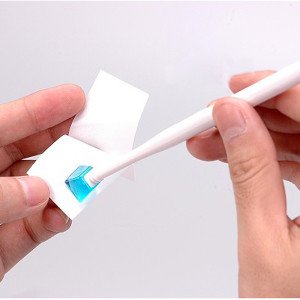Overview
The Eyelead dust-sticking brush SCK-1 has a adhesive rubber head with a high viscosity which will allow you to effectively remove dust from the sensor of your camera. Using the Eyelead dust-sticking brush is a very efficient and secure way to clean the sensor or lenses. It doesn’t leave any traces or marks at all. The 10 adhesive cleaning papers that come with the dust-sticking brush will allow you to re-use the SCK-1 up to 100 times before it loses its qualities and effectiveness. These adhesive cleaning papers are used to clean the head of the dust-sticking brush, removing debris by pressing the rubber head onto the cleaning papers.

– Sensor Gel Stick
– 10 Pack of Viscous Cleaning Papers
– Aluminum Box
– Manual
Item Details:
This sensor cleaning kit includes the sensor gel stick and viscous cleaning paper to clean the gel. The kit should be used at room temperature (70 degrees) for maximum effectiveness. using the gel stick in humid or moist environments could result in the gel not being sticky. DSLR cleaning kit can be used for any brand of camera, you can read the manual to know more about that.
The viscous cleaning paper is coated with a non-shedding colloid material. It is helpful to clean the dust on the sensor gel stick prior to using each time. To use, peel off the sticker,and cleaning the dust gently from the gel.
Tutorial
While using one of these gel sticks, the most important thing to remember is to take your time, follow directions, and always keep in mind how delicate your sensor is. Below, you will find a video tutorial by our friends over at fstop lounge. Be sure to watch it completely. You will see how important the direct up-and-down motion.
- Follow the instructions for preparing your camera for sensor cleaning. For DSLR’s, this invariably means starting with a fully charged battery and working in a clean, well-lit room.
- As always, start off with a dust blower to knock off the loose dust first.
- Press the gel head straight down into the the portion of the sensor where the dust is. Do not swirl or rub. Do not use force (obviously) but do press deliberately so that there is adequate contact.
- Lift straight up. The gel has a stronger adhesion to dust than the dust does to the glass.
- Press the gel head into the supplied special adhesive paper. The paper has a stronger attraction to dust than the dust as to the gel. If you were successful you should see dust spots on the adhesive paper.
Comparison
So what makes the sensor gel stick so much different than any other form of cleaning? We have provided an in-depth analysis and comparison of the methods available to clean your camera’s valuable sensor.
There are three major differences in the sensor gel stick and traditionally cleaning of the sensor swab. The first major item is the ease of use. A sensor swab requires many more steps, including using a liquid substance which happen to be item two. Using any type of liquid while cleaning the INSIDE of your camera just scares the heck out of us. The sensor gel stick is completely liquid free and uses a patented technology to lift dust and debris from your sensor.
Item three is a big. Item three is the motion in which you clean your sensor. How do you scratch a surface? You simply move horizontal along along that surface. The biggest advantage of the sensor gel stick is the movement in which you use to clean it. Instead of moving horizontally across the sensor and risk scratching the surface, the gel stick uses an up and down motion. Never giving the opportunity to accidentally scratch your sensor. It’s that good!
Where To Buy
There are not many places in the United States that you can purchase a sensor gel stick. We listed the reputable places below.
Amazon USA – $49.99 (04/01/2016)
Reviews
We’ve taken some of the most detailed reviews from influential people around the internet and have put them into one place for you. Head on over to our review section and check them out. Additionally, if you would like to submit a review to our repository of feedback, please send us an email via the contact form.
